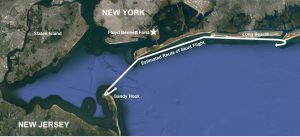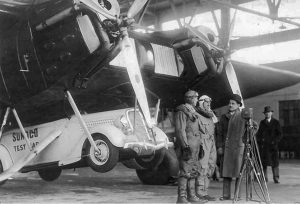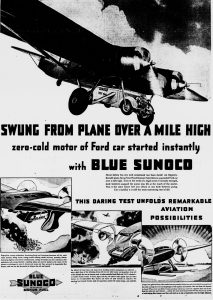
A New Height In Publicity, Part 2
Part 1 presented the circumstances concerning the development of the very creative marketing stunt developed by Sunoco in 1935 to promote a new gasoline. The highly unusual nature of this event required that the major players involved possess equally unusual experience and skills as was detailed in that prior narrative. Part 2 relates the rest of the story of a unique combination of automotive and aviation technology utilized in a demonstration that deserves a lasting place in marketing textbooks.
The New York area was still digging out of the season’s biggest snowstorm on the day of the flight per Sunoco’s news release. The runways at Floyd Bennett Field were freshly plowed and all arrangements were complete. The UB-20’s open cockpit, its position atop the fuselage, and lack of an intercom eliminated voice and visual communications between Reichers and Zeke Meyer’s station in the cabin. These elements also prevented Reichers from being able to see the roadster. As a workaround, one of Burnelli’s junior engineers, only identified as “Hugh”, volunteered to go on the flight and relay hand signals from Reichers to Zeke.
Weather conditions were perfect for the flight. The ground temperature was 15°F, therefore they anticipated finding 0°F at 5,000 feet in the day’s clear skies. The UB-20 and observation plane took off on schedule at 10:00am. In the air, Reichers was relieved to discover that the addition of the car did not cause any airflow disturbances affecting the plane’s tail surfaces and controls. However, the effect of turbulence was another matter; the bouncing of the plane in rough air and the effect of the car’s weight produced pendulum-like motions that resulted in Reichers having to continuously fight the controls in order to maintain level flight.
When the UB-20 finally reached 5,000 feet it was over the Atlantic Ocean off Long Island. Reichers noted at that time that his outside air temperature gauge read 0°F. The pilot of the observation plane, famous aerial photographer and surveyor Victor Dallin, must have seen the same thing. Per the plan, he then began moving his plane close-in so that the film crew aboard could begin shooting to confirm the car starting up in the frigid temperature. Because Reichers could not see Zeke from the cockpit and thus directly communicate with him, he gave a head motion to Hugh that it was time for Zeke to drop through the trap door and start the car. Here is what happened on the rest of the flight as related by Reichers, again from his book The Flying Years:
“I followed the Long Island shore to Long Beach and then made a flat turn and flew back to Sandy Hook. I flew this same route, back and forth, until I was tired out. The observation plane, piloted by Victor Dahlin (sic), kept in close formation beside me, but never gave me the signal that they had taken enough pictures. I motioned to Hugh with my head that he was to go back into the cabin; and I pointed down toward the car – I wanted to know how Zeke was making out. Hugh returned in a few minutes with a big smile and nodded his head vigorously, but the other plane still flew in close formation. I couldn’t understand this. We had now been up for over an hour, twice as long as the cameramen had estimated would be necessary. I raised my hand so that Vic Dahlin could see, and gave him the signal that I was going to land. He pulled away and I headed for the field. Luckily, the wind was straight down the runway, minimizing any tendency to ground-loop into the snowbanks. Except for a little difficulty in getting the tail down, the landing was normal. Before I had rolled to a stop and turned around to taxi back, Hugh climbed into the cockpit and yelled into my ear, ‘Zeke! He never went down into the automobile! He strapped himself into a rear seat just before take-off, and he’s still sitting there!’”

Reichers flew the UB-20 repeatedly on an approximately 30-mile route, well past the estimated time to complete the stunt.
After such an arduous flight, Reichers blew up. He pointedly told Hugh that his previous signal was for him to confirm that Zeke had carried out the stunt, and that Hugh appeared to give an affirmative response. Hugh sadly apologized for his misunderstanding, as he thought Reichers just wanted to know if the car was still there.
While unsure of his next step, one thing that Reichers was sure of was that he did not want to repeat the flight. To buy some time, as they taxied back to the hangar he commanded Hugh to not say anything to anyone. He further directed Hugh to inform Zeke to remain silent as well, and to act as if everything went as planned.
Once they were back at the hangar, Reichers saw that all equipment was set up and that newscaster Lowell Thomas was waiting to interview Zeke and him about the flight. It quickly became apparent that no one on the ground knew that the flight had been a bust. One of Sun’s publicity men pulled Burnelli aside to talk, probably informing him of the situation, so Reichers stayed in the cockpit to await Burnelli’s arrival there. When Burnelli came aboard, Reichers heatedly told Burnelli what happened and wondered aloud as to what he was supposed to say in the post-flight interview. Burnelli patiently explained that Sunoco’s publicity team wanted to go through with the interviews as if the flight had been a success. One of their team was at that moment coaching Zeke as to what to say. Further, they wanted to do another flight after all of the hoopla was over, this time with clearer signals to Hugh and Zeke to preclude any misunderstanding.
Reichers was naturally livid at the request for another flight. After flatly refusing to do so in no uncertain terms, Burnelli had one more piece of bad news. Sunoco’s publicity team had released full-page ads in the country’s major newspapers as soon as the planes took off in their eagerness to get the release into the evening editions.
Reichers now realized that Sunoco’s premature action had forced him into repeating the flight, which made him “mad enough to chew iron”. Luckily, the interview with Lowell Thomas went very well, as most of his questions concerned the car’s performance; with Zeke answering those inquiries Reichers’ participation was minimal. And as Reichers dryly stated in his book, Zeke’s prepared speech (courtesy of Sunoco) “was a dilly.”

Zeke Meyer delivered a “dilly” of a speech in the post-flight interview with Sunoco’s radio announcer Lowell Thomas.
Later that day Reichers and crew repeated the flight, and this time Zeke successfully started the car. After the film crew completed their work, Reichers prepared to land. However, Murphy’s Law was working overtime. In this case, the car caught fire because Zeke started it with the dashboard throttle, then hastily climbed back into the plane with the car’s engine running wide open and its manual radiator shutters closed. This caused the engine to overheat and oil in the crankcase to ignite. Luckily, Hugh was also aboard this flight. After informing Reichers of the fire he went back into the cabin and quickly extinguished the blaze by turning off the car’s ignition. The eventual landing was not the smoothest of Reichers’ career but it occurred without further issues.
A couple of additional items concerning this stunt are worth noting. First, an example of several full-page ads that Sunoco developed about the stunt as part of their subsequent campaign is included on the next page. It also contains perspectives on the potential use of aircraft to carry other vehicles, perhaps to illustrate Blue Sunoco’s capabilities in these machines. Second, movie footage of the UB-20 hauling the Ford roadster still exists (incorrectly identified as occurring in 1934) and can be viewed on YouTube.

This full-page ad for Blue Sunoco is from the February 14, 1935 edition of the former Washington (DC) Evening Star. It is dominated by an illustration of the Ford roadster attached to the UB-20 and contains brief details of the flight. What is also notable is that it speculates that the test stunt is a foretaste of the use of aircraft to transport different types of land vehicles (fueled by Blue Sunoco, of course) in various scenarios for disparate applications. This may be meant to tacitly underscore the message of the gasoline’s ability to provide performance in a variety of climates. Interestingly, although aircraft have not been utilized to carry external land vehicles, starting later in World War II and into the present transport aircraft have carried all kinds of vehicles internally to locations worldwide for civilian and military uses.

